Product Strategy Guide — Template & How To (2023)
Developing a winning product strategy is crucial yet complex. This comprehensive guide distills the core frameworks product managers need to craft a strategy that delights customers and dominates the competition. Get ready to level up your strategic thinking.

Align your company and team around an innovative and disruptive strategy
Easy right? Developing a successful product strategy is crucial, yet complicated, and worse, it's often poorly understood and executed.
It requires aligning...
- Business objectives...
- Customer needs, and...
- Product vision...
... into an actionable strategic plan. And each of those need to be clear, actionable, and impactful.
You can't just check the box on strategy.
I'll guide you through this and break down the core frameworks product managers need to craft a winning strategy.
You'll learn how to connect your product to the overall business strategy, understand target customers deeply, develop go-to-market and growth plans, and create roadmaps to achieve your vision.
With clear examples and practical advice, this guide provides you the strategic thinking all product managers and leaders need to delight customers and dominate their category.
Equipped with these powerful mental models and frameworks, you can level up your product strategy skills and lead your team to success.
By the end, you'll have broken down core frameworks for developing a winning product strategy for your customers.
In this guide, you'll learn...
- How to start with a template for your 12-month product strategy
- Foundational strategy concepts to go from business to product strategy
- Frameworks for understanding your target customer and their needs
- How to align your product vision with the overall business strategy
- Tips for developing your go-to-market and growth strategy
- How to craft a product roadmap that delivers on your strategic vision
- Real-world examples of effective product strategies

Get Started: A Product Strategy Template
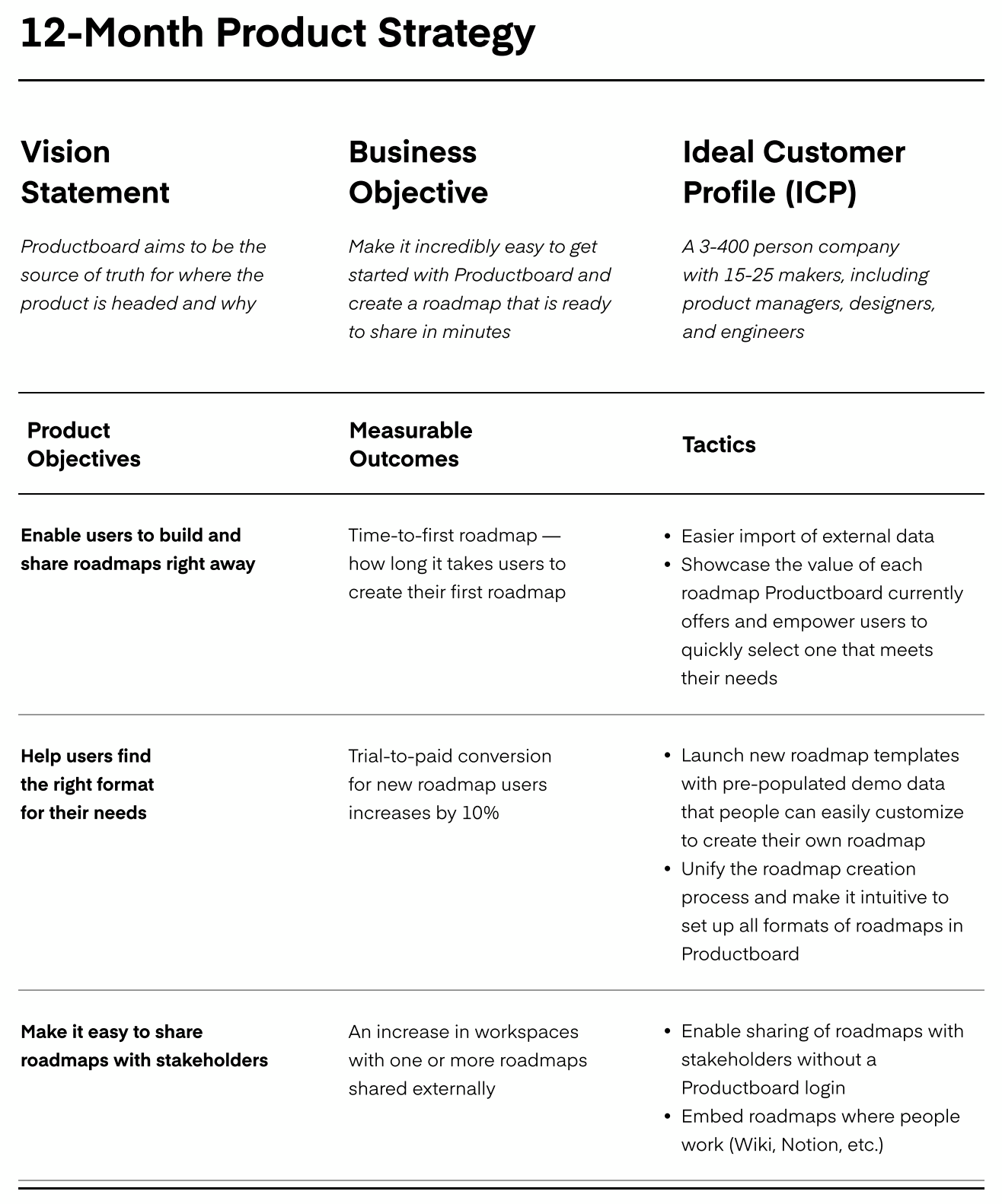
I know – you just want a template to get started quickly.
But hold up.
Effective product strategy is about so much more than just filling in a template.
Yes, the core components of a strategy do follow a similar structure.
But cookie-cutter templates rarely lead to original, thoughtful strategies that motivate teams and drive results.
The real magic lies in the strategic thinking and sharp decision-making required to craft each element of your strategy.
Your product strategy is the game plan for delighting customers and dominating your market. But over time strategies grow stale, lose relevance, or fail to adapt. Even the best strategies need regular tune-ups and realignment. Successful products happen because the teams behind them understand their customers.
This includes making tough choices on where to play and where NOT to play in the market. Defining a differentiated and customer-centric vision for your offering. Painting a vivid picture of future success that rallies your teams. And selecting focused objectives and metrics that ladder up to core business goals.
While a template provides helpful guidance, the hard work is up to you. You must customize every aspect to reflect your unique customers, market dynamics, and business objectives.
So use any template as a starting point, but not an ending point. Let it guide your strategic analysis and conversations. Then pour your insights into crafting a strategy with meaningful impact.
We created this template to help you quickly articulate your strategy to help you socialize and iterate the plan.

Crafting a powerful product strategy is crucial to align your team, delight customers, and achieve business goals. A great product strategy describes how you will win – but what makes a strategy truly impactful? Follow these best practices:
- A vision statement inspires your team by vividly describing the ideal future state of your product and how it will revolutionize your customers' world. A compelling vision unifies teams around a shared purpose.
- The timeframe should align with your business planning cycles, typically 12-18 months. Set a window that allows for ambitious goals while remaining grounded in reality.
- Business objectives explicitly connect your product plans to the company's core financial and strategic goals. Demonstrate how your product moves the needle on revenue, market share, customer retention or other vital metrics.
- A well-defined audience gets crystal clear on your target customers. Detail their needs, behaviors and values so your team has empathy for who they are optimizing for – this is your target audience who will love your product.
- Product objectives identify the critical customer problems your product will solve. Objectives create a roadmap for your team to follow when defining features and capabilities.
- Measurable outcomes help you track progress through quantitative metrics connected to your objectives. Identify leading indicators that provide an early signal of success.
- Tactics are the detailed initiatives and game plans for accomplishing objectives. Outline roles, resources, timelines and success metrics for each tactic.
With these essential elements, your product strategy will focus your teams' efforts to maximize results and delight your customers.
What is Product Strategy?
Product strategy is the overall plan for developing and marketing a product. It includes the product's vision, mission, and objectives and the strategies for achieving them.
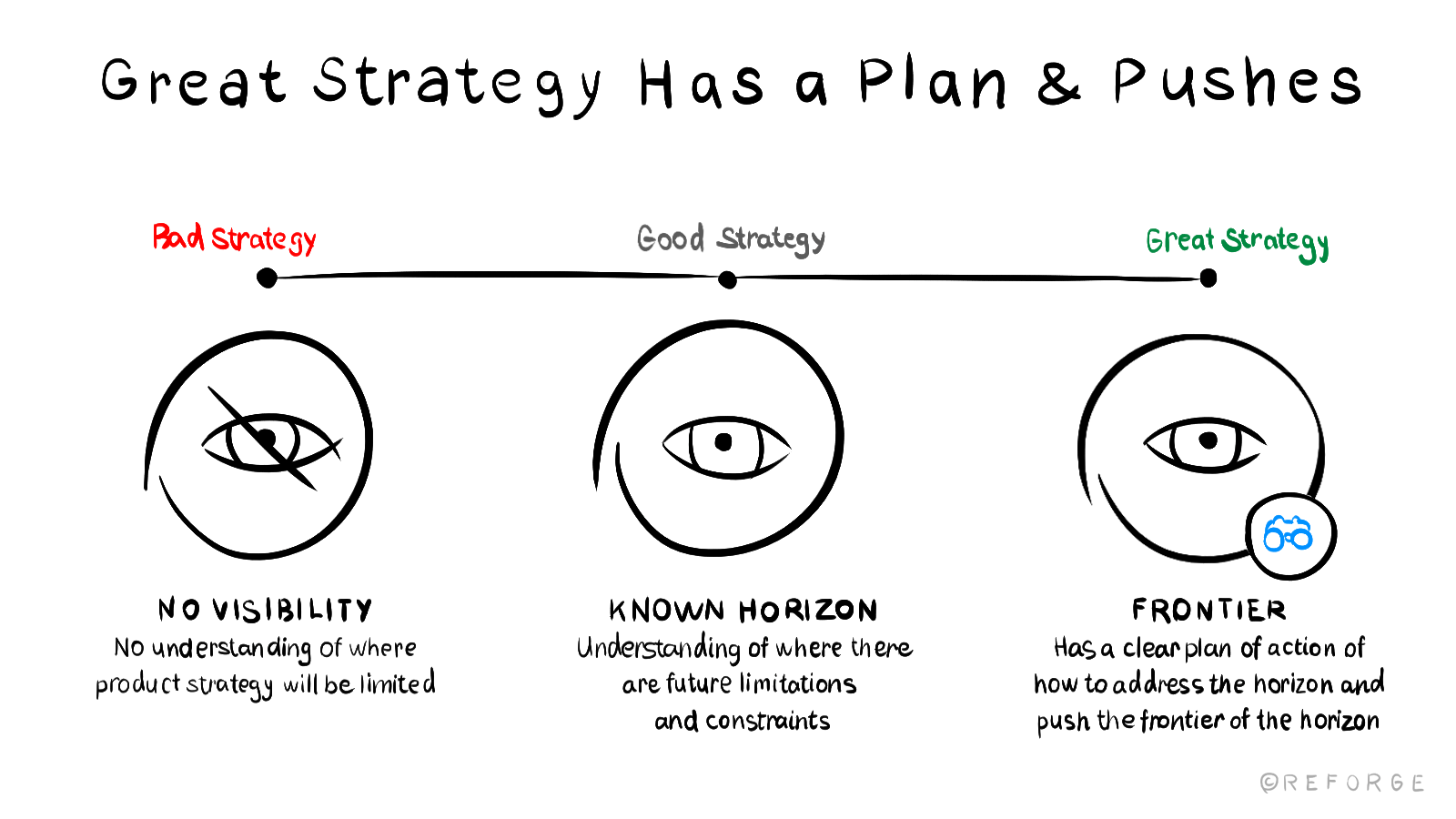
The start of any product strategy is first to understand the needs and wants of your ideal customers – the intended audience for all of this effort. Once you know your market needs and wants, you can create a product that meets those needs and wants.
One of the most critical aspects of product strategy is market research. You need to understand your target market, what they want, and how to best reach them. You will need to have a clear idea of your product's features and benefits and how it differs from existing products on the market.
Additionally, you'll need to have a clear vision for your product, as well as a roadmap for how you plan to bring your product to market. Finally, you'll also need to establish key metrics to track the success of your product.
Once you have a solid product strategy in place, you can start marketing your product and bringing it to market. Having a well-defined strategy will help you make informed decisions about allocating your resources and growing your business. When launching an entirely new feature or product, it's crucial that the product and marketing campaign is tightly aligned to ensure maximum impact.
At the end of the day, great product management is simply great product strategy execution.
Why is Product Strategy Important?
Product strategy is important because it helps a company determine what products to develop and how to position them in the market. In addition, a well-developed product strategy can help a company achieve its goals and objectives.
Your strategy includes key decision-making factors about how a company will introduce, price, and market its products. For example, the strength of a well-devised product strategy can positively affect a company's revenue-generating ability and brand reputation.
A good product strategy provides direction for your entire business. In particular, it can help you gain clarity about which markets to compete in and whether to launch new products or retain existing ones. But knowing what makes a great product strategy is easier said than done – especially since there are so many different approaches.
Even if you do come up with one, it doesn't guarantee success.
Bad Product Strategy
A bad product strategy is disconnected from customer needs and values - if you don't know what your customers want, then there's no way that you'll be able to provide it for them.
Failure to meet market demand - if people aren't interested in buying and using your product, it doesn't matter how good your development processes are. Businesses often grow by diversifying into new areas of opportunity but not every opportunity should be pursued just because it looks good, especially if it does not play to the core business strengths.
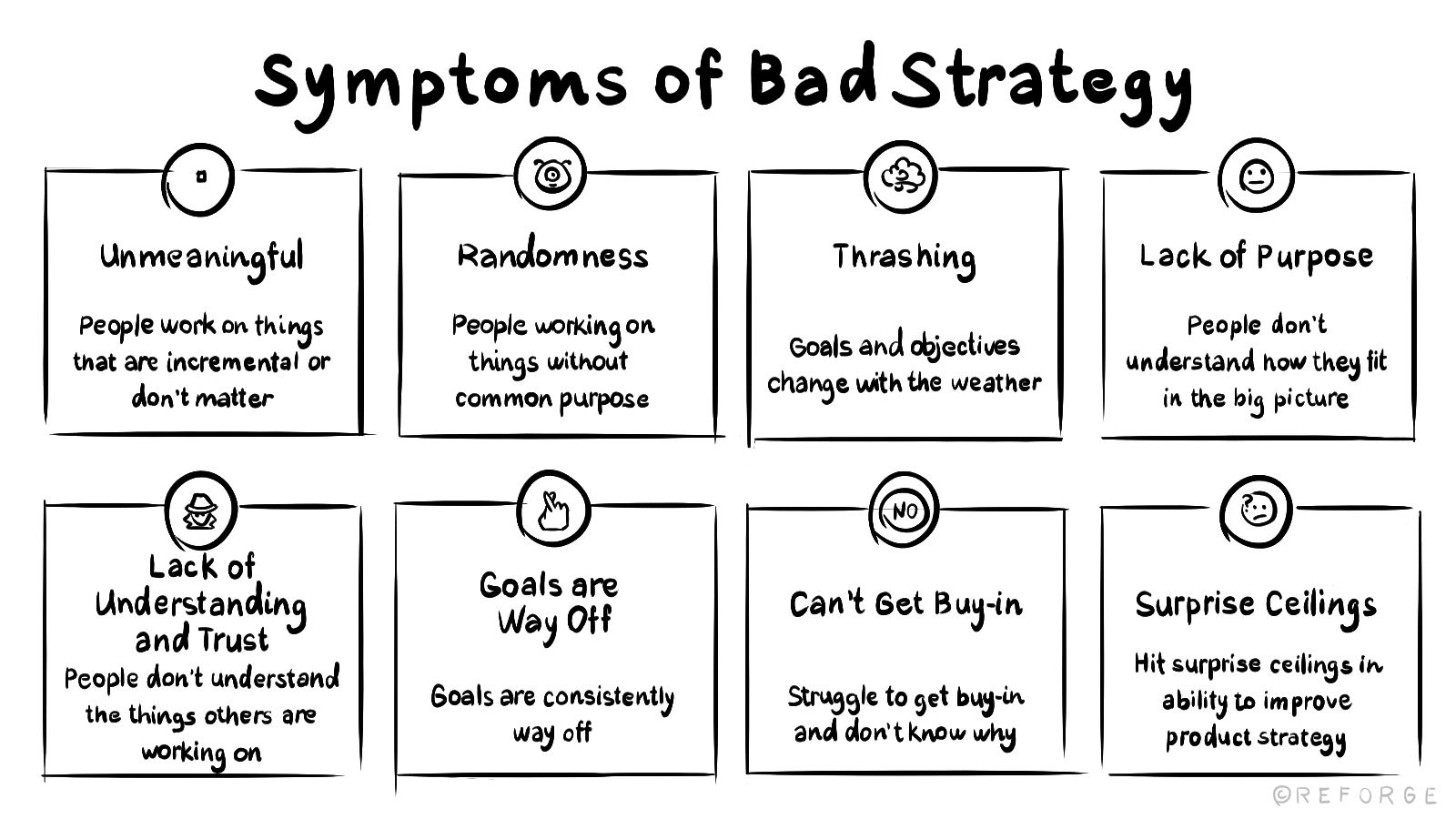
Good product strategies don't just focus on your core strengths and value proposition; they can also avoid any possible issues before they become a problem.
For example, you might find that by avoiding one type of customer segment, you could prevent yourself from having to deal with lots of returns, complaints, or legal issues. A well-defined segment makes it easy to find real people to talk with to understand your market.
Product Strategy Framework: How to Define Your Product Strategy
A strong product strategy is well-aligned with the company's overall strategy and meets your target market's needs. Your strategy must be clear, concise, and easy to understand to be successfully executed. The product strategy should also be achievable and realistic, and it should take into account the company's resources and capabilities.

It's the glue that holds all work together and provides a common framework for employees, creating alignment between different teams within an organization. Everyone from marketing, engineering, and leadership should understand what the company is trying to accomplish.
A great product strategy is a playbook for the entire company, and it includes the following elements:
- Vision
- Strategic pillars
- Ideal customer profile
- Jobs to be done, or use cases
- Channel and positioning strategy
- Measures of success
- Bets to make
You can analyze additional product strategy frameworks to find the right elements for your business.
7 Powers: The Foundation of Business Strategy
In the book 7 Powers by Hamilton Helmer, he discusses making a company enduringly valuable. It is based on the idea of power, which is the potential for differential returns. The book outlines how to achieve power and use it to make strategic decisions.
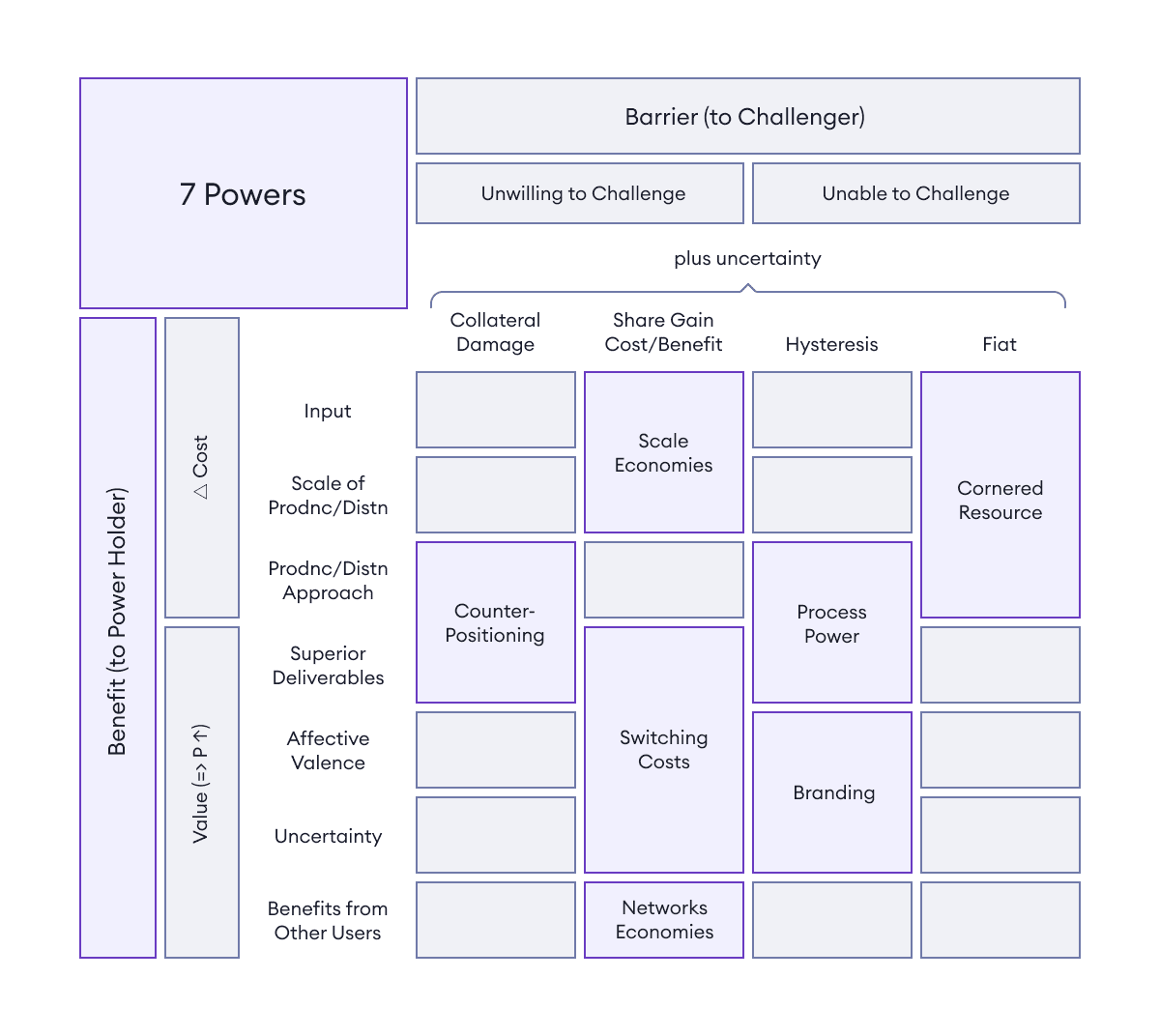
Economies of Scale
Economies of scale are reductions in unit costs due to an increase in the scale of production. They arise from the increased utilization of capital and labor, the spreading of fixed costs over a larger output, and the learning that comes with experience. If you can produce something cheaply, you should benefit enormously from economies of scale.
Network Effects
Network effects are positive externalities that arise when one individual's use of a good or service increases the benefits enjoyed by other individuals. Network effects are important in tech businesses because they can make a product more valuable as more people use it.
In the context of telecommunications and information technology, network effects arise when the number of users of a communications network or service increases the value of that network or service to all users.
The classic example of a network effect is the telephone. The more people who have telephones, the more valuable the telephone network becomes to each individual because the telephone network allows individuals to communicate with more people.
Other examples of goods or services that exhibit network effects include:
- Social networking websites (Facebook, Twitter, LinkedIn)
- Online marketplaces (eBay, Amazon, Alibaba)
- File-sharing platforms (BitTorrent, Dropbox, iCloud)
Counter Positioning
Product positioning is the process of designing the marketing mix for a product such that it occupies a distinct place in the minds of consumers.
Counter-positioning creates a brand and business model that competitors have conflicting incentives with, preventing them from competing effectively.
Switching Costs
Switching costs are incurred when a customer switches from one product to another. These costs can include the cost of retraining employees, the cost of lost productivity while employees are retrained, and the cost of lost customers. If these costs are high enough, it may prevent customers from switching to a competitor's product.
Brand
Brands are one of the most powerful and durable kinds of moats, but take the most time to build, are complex, and require thoughtful attention.
Brand building is important to product strategy because it can help a product become more successful by connecting with customers. A strong brand can help a product stand out in a competitive market and makes it easier for customers to trust and recommend your product.
Cornered Resources
A company corners a resource when it somehow gains preferential access to it. Resources include intellectual property, human capital, physical resources, distribution channels, and access to capital.
Process Power
Process power is the least obvious power, which can be extremely difficult to replicate. The process is deeply embedded inside the organization and its culture and may not be documented in any form. It goes beyond the steps to execute and into principles and values.
Building the moat
The key to making a company enduringly valuable is establishing power in your business's Origination, Take-Off, or Stability phases. It is unlikely that a business will develop a power moat once the business is in decline.
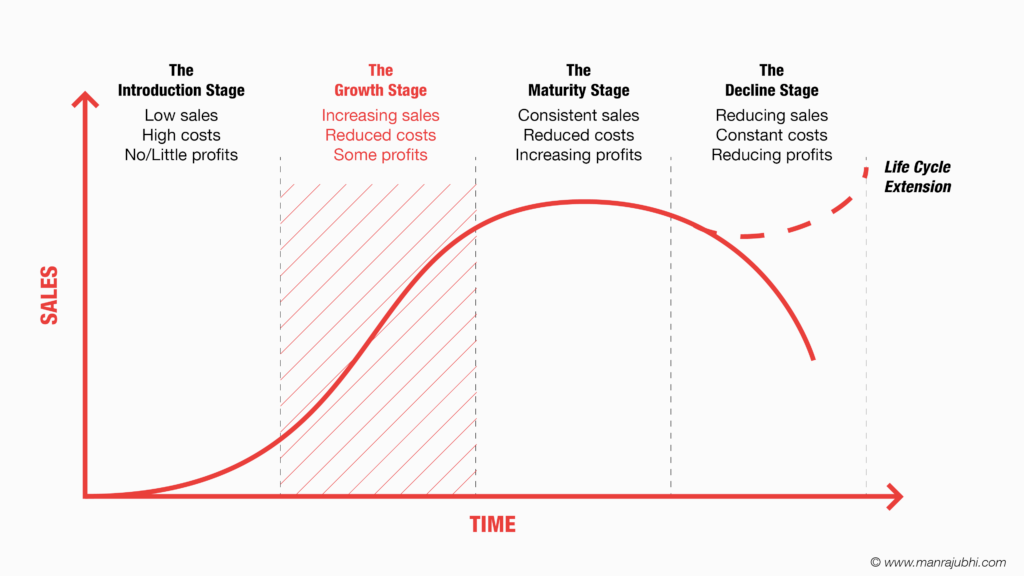
Product Flywheel
A product flywheel is a model for product strategy that businesses need to make sense of and evaluate the digital experiences and customer behaviors that lead to long-term value, and ultimately, create a sustainable competitive advantage. Your flywheel contains key inputs that are leading indicators that measure success.
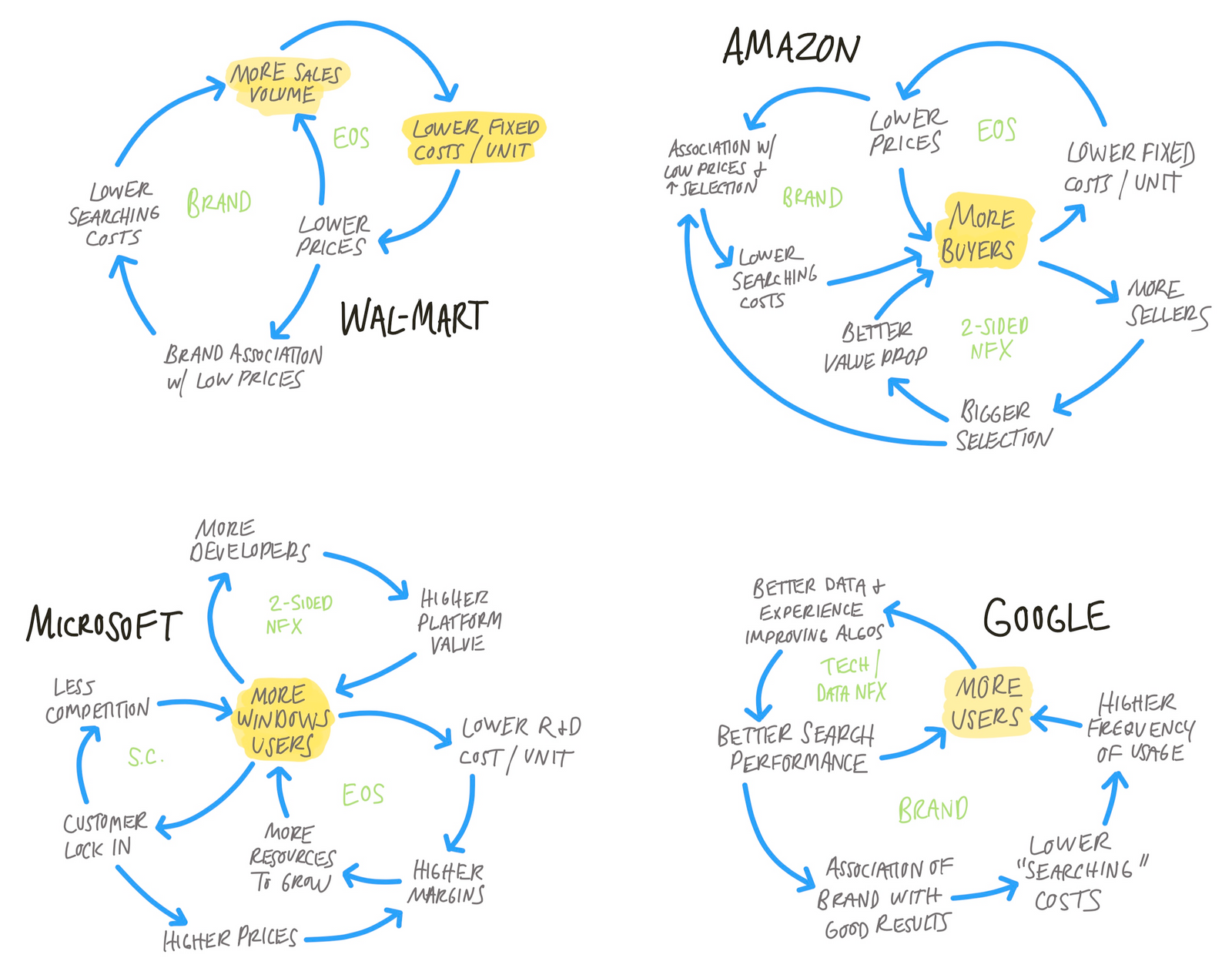
It requires a lot of energy and momentum to get it started, but it's very difficult to stop once it's up and running. So the key to creating a successful product flywheel is balance. You need to have a product that people want, but you also need to quickly and efficiently turn that demand into revenue.
A product flywheel is a framework that helps businesses understand how their products and services work together to create value for their customers. It's a way of thinking about your product strategy that considers how customers interact with your products and how those interactions create value for them.
Learning Faster
The product flywheel is a model which identifies the categories where your product provides value to your customers, making it easier to improve and invest in these categories. It helps product teams identify the motions of their flywheels through experimentation and data-informed product decisions. A clear and strong product strategy aligns teams across the company, focusing on generating unique insights for your business as you ship and learn. Product teams must balance discovery and delivery in parallel, integrating customer insights regularly as they launch new experiments and features.

B2C Apps
B2C companies appeal directly to one buyer enabling short sales cycles with the potential of a high volume of customers. The core of any B2C business is user growth: more people using the product, resulting in more potential for attention, engagement, or transaction. Product teams will need to identify the leading behaviors that signal customer retention and conversion.
Rewarding desired actions and decreasing friction accelerates the B2C flywheel.
B2B SaaS
The B2B flywheel is all about creating a virtuous circle of growth and profitability for the company. It starts with identifying and targeting business customers and then providing a valuable service essential to their operations. Continued growth is fueled by word-of-mouth referrals and expanding usage as the company grows. And finally, profitability comes from upsells and expansion into new markets and customers.
The objective of a B2B SaaS flywheel is to figure out how to get a business customer to integrate their product into critical operations. It may begin with one department, but the aim is to gain more users and departments, expanding with the business (i.e., land and expand).
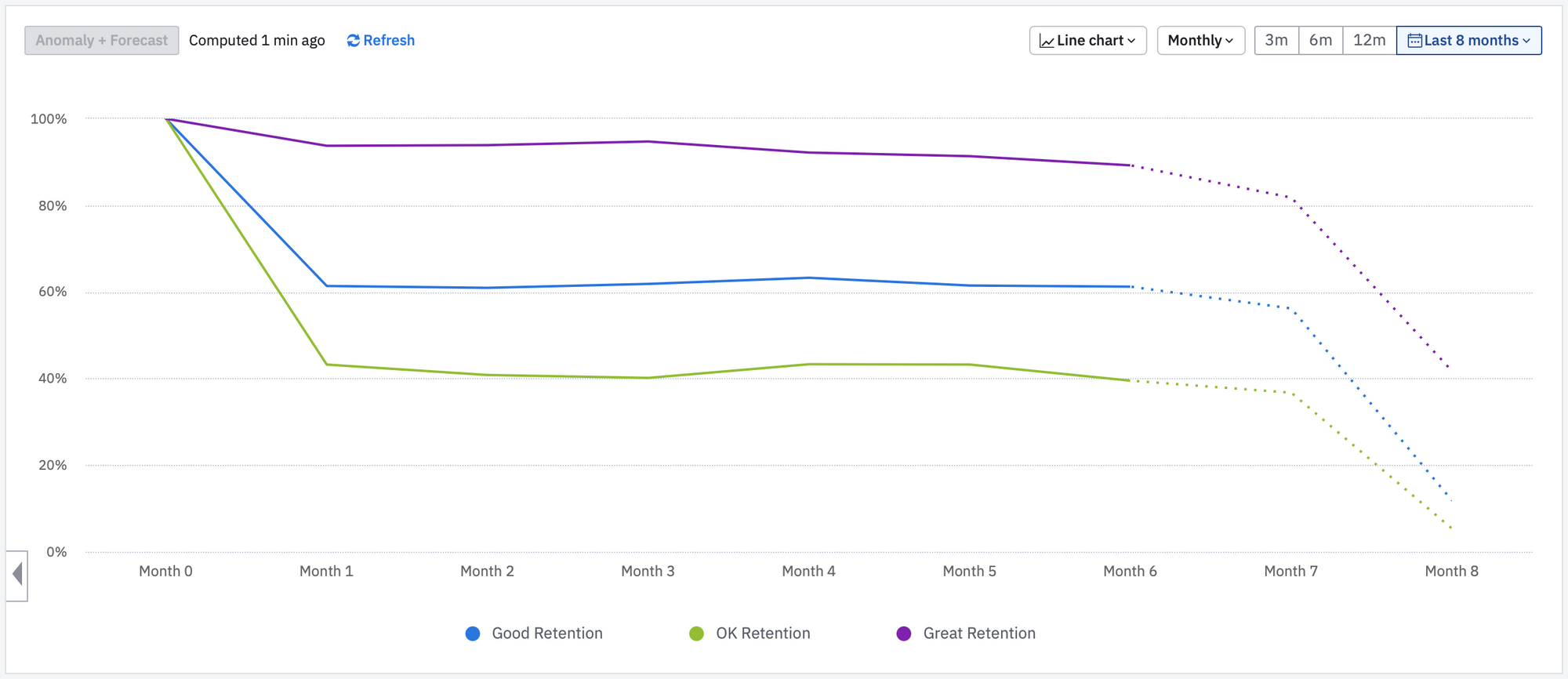
Flywheel Goal
The goal is to create a flywheel of customer loyalty and buying, leading to more sales and profits. A product flywheel is important because it can help a company increase its sales and profits. There is no one-size-fits-all flywheel model, as the flywheel will vary from business to business and must consider the company's products, services, and market. Additionally, it's important to think about what motivates customers to buy from a business.
Your product strategy should answer the following questions:
- What are the key promises your product makes to different customer personas?
- How does your company need to grow and scale in different areas to support the product?
- What is the competitive landscape, and how does your product compare?
The flywheel concept can be applied to many different aspects of business; we'll focus specifically on how teams can use it to improve product development. A product flywheel is about understanding which digital experiences and customer behaviors lead to long-term value.
The Power of Product Strategy
A strong product strategy is required to link the company's goals with the product. Businesses employ various techniques based on one another to ensure that the team is aligned. An effective product strategy entails knowing where it falls within the high-level corporate vision and roadmap plans. A product strategy outlines how you will make tradeoffs to reach your goals.
The product strategy builds upon employee passion for the company mission, grounding it in reality with tactics and success measures. After defining your product strategy and aligning product teams, you'll move to plan themes, objectives, initiatives, and the execution plan. Initiatives are merely projects linked to the strategic themes or objectives you derive from your product's goals that are placed on your roadmap. Individual teams must break initiatives down into actionable tasks to achieve product objectives.
Linking Product Strategy to Business Goals
A strong product strategy must align with the broader business goals. As a product manager, you need to understand the key business objectives and consider how your product strategy can help achieve them.
Great product strategies don't happen in a vacuum. To create maximum impact, you need to directly align your product vision with the core business strategy and objectives.

But how do you connect the dots between broader company objectives and your concrete product plans?
When defining your product strategy, start by reviewing your company's overall goals. Discuss these goals with leadership to determine which ones your product can directly impact. Common business goals include growing revenue, expanding market share, reducing costs, and improving customer retention.
As you formulate your product strategy, constantly refer back to the business objectives. Ensure your product vision and roadmap will realistically move the needle on one or more goals. Track how your product metrics tie to high-level goals.
Getting alignment on goals upfront enables you to craft a focused product strategy. The more your product strategy ladders up to core business goals, the more buy-in you will get across the organization. Spend time communicating how your product direction delivers on business goals.
Make sure your product team understands which goals their work relates to. This context helps them prioritize effectively and make smart trade-offs. When new business goals emerge, re-evaluate your product strategy and make adjustments if needed. Frequent check-ins on business goals will keep your product and company aligned.
With your product strategy tightly integrated with your company goals, you can drive growth and innovation while delivering value to the organization.
Follow these steps to build product strategy alignment with the business goals:
- Connect to Vision
Start with the company vision. Review the overarching vision and mission for insights on where the business is headed. This high-level perspective guides your strategic product thinking. - Understand the Goals
Dig into the business motivators and goals. Have candid conversations with company leadership to uncover the tangible goals your product needs to drive forward. We're talking clear goals like: increase revenue 20% from the enterprise segment, expand market share of a specific feature or product line by 30%, or reduce customer churn from this segment by 15%. - Create Product Measurements
Connect product KPIs to business goals. Now examine how your key product metrics ladder up to those business objectives. Can you draw a straight line from your product KPIs to the results the business seeks? Tight alignment here gives your product strategy immense momentum. - Build Influence and Alignment
Communicate connections to your team. Ensure everyone understands which business goals their product work impacts and how. This context gives purpose and priority to daily tasks. - Bi-weekly Checkins
Regularly re-confirm alignments. In dynamic businesses, goals evolve. Routinely check that your product strategy still maps to the most crucial business objectives. Make adjustments as needed.
Following this process cements your product strategy to the company's top-level needs and desired outcomes. When your product vision clearly ladders up to business goals, you have a strong foundation for delivering outstanding value.
Product Vision
A corporate vision is a high-level view of what the company wants to be, while a product vision statement is often a short, sweet, and static statement about what the product aims to achieve.
Writing a great product vision statement will take several iterations, but it's worth the time invested in getting it right.
Product vision defines what a product should be and how it should help customers. It is a high-level statement that should answer the question, "What are we trying to achieve with this product?" It is created by determining what the product should do for customers, what features it should have, and what benefits it should provide.
The vision or mission statement should be easy to remember and understand, not tactical, and aspirational while remaining vague.
Product Roadmap
Every great product strategy has a roadmap. A product roadmap translates strategic priorities into a clear sequence to coordinate team execution. As part of successful product strategies, roadmaps enable focus and alignment.
- Sequencing Strategic Themes
Map out initiatives under each strategic theme on a timeline based on dependencies, resources, and priorities to guide the team. - Balancing Horizons
Balance short and long-term objectives. Include quick wins to gain momentum alongside initiatives working towards broader market leadership and business aims. - Evaluating Tactical Decisions
Ensure the team's tactical decisions align to the roadmap and ultimately the product's success. Say no to out of scope requests that detract from strategic focus.
An excellent roadmap cascades from vision to objectives to tangible execution. It crystallizes business goals into prioritized, actionable plans that set teams up for delivering maximum value. A roadmap is the product strategy in motion.
Your product roadmap will help focus execution against your business goals. For example, a product roadmap can help execute a niche strategy in a few key ways clearly sequences initiatives that target the niche and deliver specialized value. A product roadmap is invaluable for executing on your strategy because it allows you to sequence projects and initiatives that directly serve specialized needs of the target segment above any other value-centric aspects.
With alignment with ultimate business goals, the product roadmap becomes a focused plan for achieving specialized success that benefits the company as a whole, and turns company hopes into a realistic plan.
Product/Feature Strategy
To be a successful product leader, you need to go from setting strategy at a visionary, high-level strategy down to helping the teams frame a feature-level strategy. You've defined the inspiring product vision and high-level strategy. Now comes the hard part - actually figuring out which specific features to build. Making the leap from broad product strategy to tactical feature decisions requires focus and discipline.
Here are some tips:
- Start with strategic product themes
Break your strategy into 2-3 key themes like "enterprise integration" or "mobile experience." This helps frame potential features. - Map features to strategic objectives
Brainstorm specific features that would advance each strategic theme or objective. Challenge assumptions on must-have capabilities. - Prioritize with strategic lenses
Evaluate potential features through lenses like business impact, customer value, feasibility, and strategic alignment. Place bets on a product strategy canvas to visualize the prioritization. - Confirm feature priorities with a council
Review your feature list with a small council of cross-functional stakeholders for refinement and buy-in. - Size features appropriately
Right-size features based on priority, resources required, and implementation timeframe. Avoid over-scoping. - Sequence features thoughtfully
Order your feature list thoughtfully based on dependencies, resourcing, and strategic impact. - Circle back to strategy fit
Before finalizing your roadmap, re-check that planned features align with your intended product strategy. - Be prepared to pivot
As you execute, continue evaluating if feature priorities still make strategic sense. Adjust tactics as learnings emerge.
Your skills evolve from influencing specific product outcomes to a broader product strategy. To do this, you need to understand what a great product strategy looks like and what it doesn't look like. A great product strategy is targeted, has visibility into the future, is fluently communicated throughout the company, and is compounding.

Product leaders should focus on features that provide ongoing value over time to strengthen user habits, create higher user satisfaction, and promote longer user retention.
To determine the best release method for your feature, you want to look at the degree of ambiguity the feature has.
- Experiment – High ambiguity features should be released as an experiment.
- Phased Release – Low ambiguity features should be released in phases.
Features in the middle should be released as a minimum viable feature. Regardless of the launch method selected, it's important to set your team up for success by evaluating the feature launch plan.
The following are the four stages of putting your product strategy into action:
- Identifying major goals: determining the key strategic objectives of your company that you can influence as a product leader.
- Mapping strategic goals into actual product development: generating and fine-tuning product concept ideas supporting your strategic objectives.
- Developing a product roadmap: sequencing of product discovery and development based on its degree of impact and urgency.
- Communicating and iterating on your product strategy: aligning the strategy with your leadership, team, and customers; and fine-tuning it due to internal and external changes.
Defining Your Target Audience
One of the most crucial elements of a successful product strategy is identifying your target audience. Being crystal clear about who you are creating value for allows you to make smart product decisions that closely align with customer needs.

So how do you go about defining your target audience?
- Persona development
Identify key user segments and create personas that capture details like demographics, values, behaviors, pain points and goals. Give your personas names and backstories to humanize them. If you have one, work with your research team on this step. - Prioritize primary and secondary audiences
Determine which personas represent the largest commercial opportunities and the primary users of your product. Also identify secondary personas who interact with your offering. This informs your customer research and the users that become your reference point later. - Detail the user journey
Map out your personas' end-to-end journey with your product. Identify key interactions and pain points to uncover opportunities. This will inform your product design process later. Build this with a cross-functional team to get a complete, 360º view of the journey. - Clarify needs and motivations
Dig deeper into what motivates your target audience to use your product. Link features to the "jobs" your audience wants your product to do. - Translate insights into strategic pillars. Let your target audience definition guide your strategy pillars, objectives and planned initiatives.
With a deep understanding of key personas developed upfront, you can craft a product strategy tightly aligned with your target audience. Keep personas at the forefront of strategic discussions to ensure you are creating outstanding value tailored specifically to your customers.
Product/Market Expansion Strategy
Product/market fit expansion strategy focuses on adding new value props to our product strategy in two different ways: adapting products to new complementary markets and adding new complementary products. Growth and feature strategy can help expand a product's value prop, but both have natural limitations that eventually lead to diminishing returns and ultimately a ceiling on growth.
Saturation is a barrier to the continued expansion of a product based on its current product-market fit. However, saturation is also something every successful company will navigate at some point. There are three types of saturation: Market (market captured reaches a natural ceiling), product (product becomes fully optimized for its use case), and PMF (decline in existing PMF). Product market fit expansion is most valuable when building off your existing product-market fit. Once saturation has started to happen, your ability to do that is much weaker. For this reason, product leaders need to identify and evaluate new product-market fit expansion opportunities proactively.
Product/market fit is something that can degrade in your product and/or market over time. This requires that product leaders continuously evaluate which investments to expand and strengthen their product-market fit.
Product Growth Strategy
A good growth strategy connects acquisition, retention, and monetization strategies to collectively expand distribution. Improving your growth strategy over the long term enhances your ability to launch successful features and products into new markets. You also need to think about growth in terms of growth loops instead of simply a flow. Brian Balfour, a leading growth expert, defines growth loops as closed systems where the inputs, through some sequence of actions, generate an output that is directly reinvested back into the system.
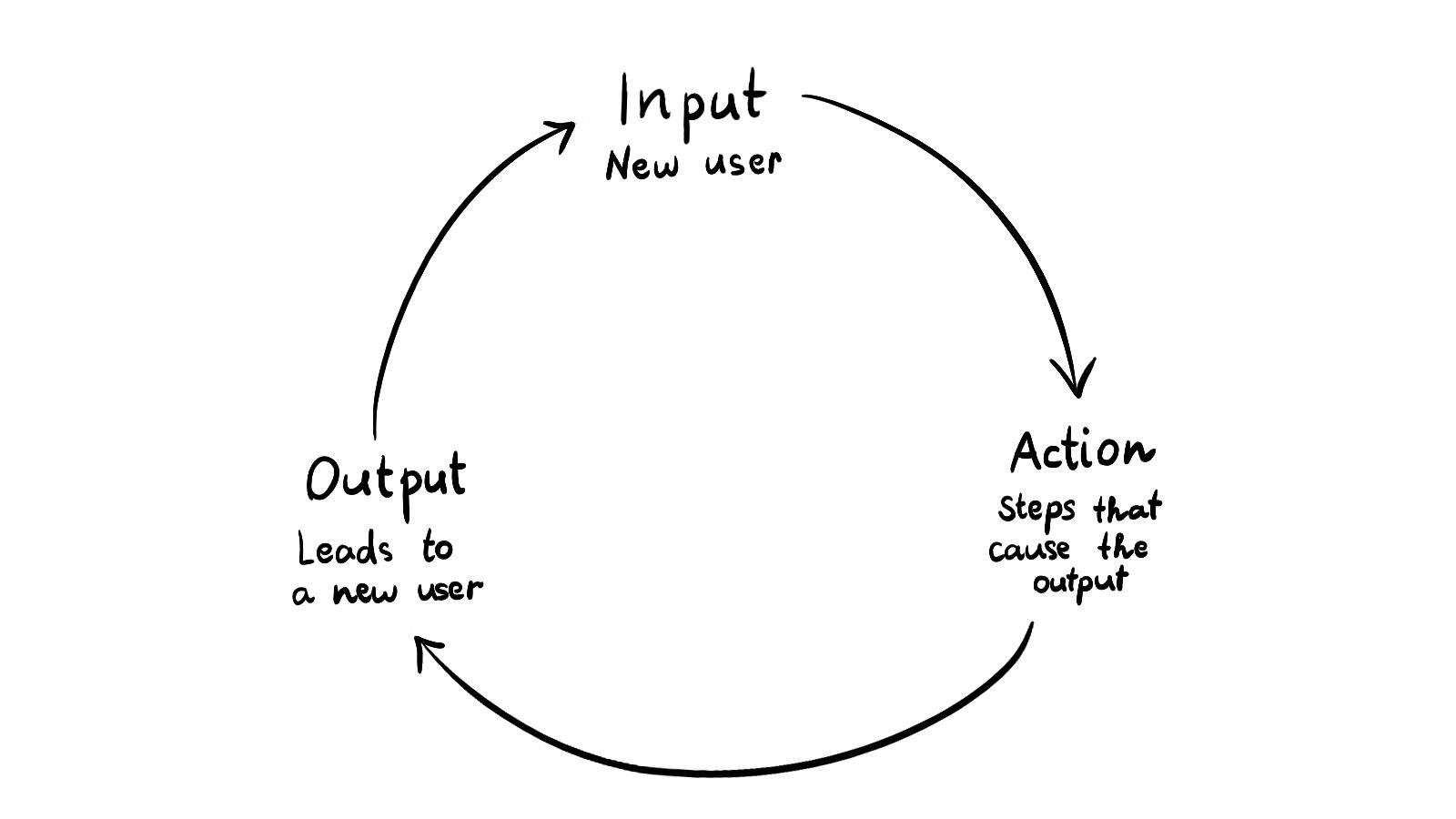
Knowing the categories and subcategories of growth loops will help you identify which types of loops exist within your product, how to improve them, and which new opportunities might exist.
There are three primary ways to create and implement your acquisition strategy:
- Optimizing steps within the loop.
- Adding a new loop to your overall growth strategy.
- Leveraging non-scalable spikes to get a new loop off the ground or feed existing loops.
To optimize your acquisition loop, remove bad friction preventing the loop from compounding faster, add good friction to reinforce its quality and effectiveness over time, and increase the throughput of a step.
To improve retention, you need to improve activation, engagement, or resurrection. And to improve monetization, you need to think about where your monetization model falls on the monetization friction spectrum and how to connect it with the consumer view and the rest of your growth model.
To think about retention from first principles for your product, start by defining your use cases. Then, the elements of your use case inform the definition and evaluation of our retention metric.
Defining a good retention metric requires clarity on:
- Who (is using the product or feature)
- Frequency (the natural rate of problem/use)
- Desired Outcome (a qualitative measure of success)
Monetization Strategy
Monetization is hard because it's a critical part of your overall growth strategy. An effective monetization model can help drive your acquisition and retention strategies, while an ineffective monetization model can completely derail them.
Product leaders need to understand what levers they can change to create the right amount of friction in the right places to maximize value capture while minimizing disruption to these retention and acquisition loops.
Leaders must understand four customer states for optimizing monetization strategies:
- Potential Customers
- Existing Healthy Customers
- At-Risk Customers
- Churned Customers
Each of these customer types has a different set of drivers for revenue growth. For potential customers, you want to move them from the potential customer state to the existing healthy customer state. For existing healthy customers, your objective is to expand revenue. For at-risk customers, you want to retain these customers and transition them back to an existing healthy customer state. For churned customers, you want to resurrect them back into the existing healthy customer state.
Improving Existing Products
The best way to improve an existing product will vary depending on the product and the company's specific needs and goals.
However, some tips on how to successfully iterate on a product include:
- Establish a clear goal for each iteration – It's important to have a specific goal in mind for each iteration of a product, as this will help ensure that each change is made with a specific purpose in mind. A clear goal will also help ensure that the team is focused and that the product is constantly evolving to meet the company's needs.
- Make small, incremental changes – When iterating on a product, it's important to make small, incremental changes instead of large, sweeping changes. Incremental changes will help to ensure that the product is constantly evolving and that teams can easily fix any potential problems or issues.
- Test and gather feedback from users – It's essential to test each product iteration with actual users to get feedback on how the product is performing. Feedback will help ensure that the product meets users' needs and that any changes made help improve the product.
Driving Growth Through New Users
A crucial element for the growth of any product is acquiring new users. Bringing in new users expands your market penetration, increases revenue, and generates invaluable data to improve your product.
Understanding your target users is key to delivering the ultimate user experience at every stage of the customer lifecycle. Here's how to align your product strategy to continuously delight new customers and existing users:
- Build empathy for your target users through research to uncover their end-to-end journey.
- Optimize the initial experience for new customers by promoting key features that deliver value upfront.
- Onboard new users seamlessly with in-app messaging that highlights core features.
- Analyze usage data to identify adoption barriers and refine onboarding flows.
- Develop educational content and tips tailored to guides users through key workflows.
- Identify power users who love your product and leverage them to provide social proof.
- Reward loyalty by surprising and delighting existing customers with surprises and exclusive perks.
- Continuously gather user feedback via surveys and interviews to guide improvements.
- Leverage analytics to predict churn risk and proactively re-engage at-risk customers.
- Cultivate brand advocates who organically refer new customers.
With an exceptional user experience optimized across the customer lifecycle, you can maximize adoption, retention, and growth. Deliver outstanding value to both new and existing customers by keeping target user needs front and center.
Developing Your Strategy Framework
Crafting a killer product strategy is no small feat. It requires equal parts strategic thinking, customer empathy, data analysis, and creative vision. But with the frameworks and best practices we've covered, you now have a blueprint for developing a focused, effective product strategy.
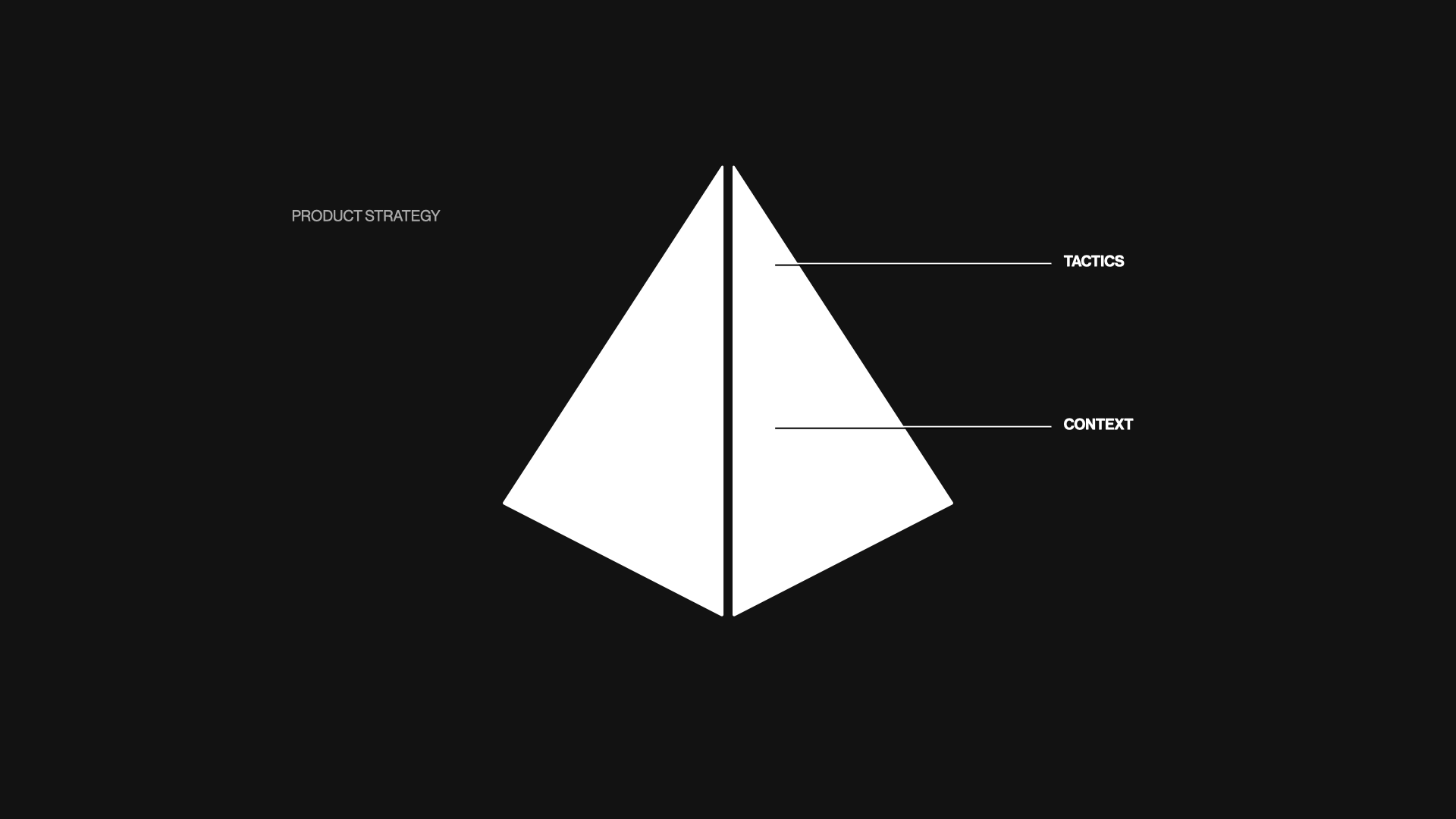
Build alignment
First, align your vision with concrete business goals to ensure stakeholder buy-in. Dig into understanding your target users on a fundamental level. Let these insights guide your positioning and roadmap. Balance long-term ambition with incremental objectives that ladder up to results.
Connect to the mission
Connect every initiative back to clear success metrics anchored to customer value. Approach your strategy as a living document, and evolve it based on market feedback and outcomes achieved.
Build shared context
With your product strategy serving as the North Star, you can empower teams to make decisions independently yet collaboratively. Rally them around providing remarkable value tailored specifically to your customers.
Customize templates to your team
The examples and advice provided illuminate the critical components of strategic thinking. But your real power comes from customizing these frameworks with your own teams' insights, creativity and expertise. Use these tips as guideposts while you craft a strategy infused with your unique vision.
Measure what matters
The ultimate measure of an effective product strategy is delighted customers who find your offering indispensable to their lives. With focus, empathy and clarity, your product strategy will point the way to achieving this success and realizing your company's purpose.
The world needs better products and you can do this with great strategy.
Now make it happen.
Frequently asked questions
What are 3 common high-level product strategy examples?
There are are 3 common high-level product strategies:
- New Market Disruption
This strategy focuses on leveraging new technology or business models to create innovative products that disrupt existing markets. Examples include companies like Uber, Airbnb, and Tesla. - Enterprise Upsell/Account Expansion
With this strategy, companies focus on expanding within their existing enterprise customer accounts by upselling new products, features, and licenses. Salesforce and Microsoft are examples of companies executing this strategy successfully. - Viral Growth
This strategy prioritizes exponential user growth fueled by viral loops, network effects, and incentives to drive organic adoption. Examples include social networks like Facebook, messaging apps like WhatsApp, and consumer apps like Instagram.
The key elements of these strategies include:
- New Market Disruption
Innovative business models, emerging tech, positioning as an alternative - Enterprise Upsell
Land and expand, bundling products/features, providing end-to-end solutions - Viral Growth
Freemium models, social sharing, network effects, referral incentives
Each strategy focuses on different mechanisms for acquiring, retaining, and monetizing customers. The strategy chosen should align with the company's strengths, target customers, and product vision.
What are example product strategies?
Here are some examples of product strategies a company may employ:
- New Market Disruption - Develop an innovative product that creates a new market and disrupts existing solutions. Example: Uber disrupting the taxi industry.
- Enterprise Upsell - Expand within existing enterprise customers by upselling additional licenses or products. Example: Salesforce upselling analytics add-ons to CRM customers.
- Consumer Packaging - Offer a freemium model and position the product as a lifestyle brand. Example: Spotify transitioning music from purchase to subscription.
- Platform Ecosystem - Create a platform that allows third-party integrations and customizations. Example: Shopify's app and integration marketplace.
- Hybrid Freemium - Offer a free version with premium add-ons and subscriptions. Example: Dropbox providing free storage with paid add-ons.
- Multi-Sided Marketplace - Facilitate transactions between two distinct user groups. Example: eBay connecting buyers and sellers.
- White Labeled APIs - Develop APIs and SDKs for third parties to integrate and sell. Example: Stripe's payment APIs.
- Direct Value Selling - Focus on ROI, security, and excellence over viral growth. Example: AutoCAD selling to enterprises based on product quality.
- Influencer Marketing - Build grassroots awareness by collaborating with influencers. Example: Early Apple products promoted by creative influencers.
- Lock-In Analytics - Provide analytics and dashboarding tools that increase customer stickiness. Example: Google Analytics.
Let's bring it all together into a simple product strategy example. An effective product strategy is consumer branding. This involves positioning your product as an aspirational brand that fits seamlessly into users' lifestyles.
Spotify employed a consumer branding strategy to transition music consumption from individual purchases to a subscription model. They branded Spotify as an essential product for music lovers. This focus strategy narrows their efforts, clarifying the roadmap and product development process to become the market leader with their customer base, and drive long-lasting brand loyalty by executing the following:
- A free tier to attract users
- Mobile adoption to meet their users where they are
- Personalized playlists and recommendations
- Partnering with influencers and brands with hip market positioning
- Marketing campaigns that cover out-of-home and digital ads
- Investing in sleek design, enhancing their product's usability
- Running targeted promotions to grow users
- Testing related features to drive long-term engagement
- Testing alternative products to improve their cost strategy
- Expanding across platforms like mobile, auto, and gaming
What are the 4 elements of a great product strategy?
While there are many types of product strategies, there are 4 key components share by all of them:
- Product Vision A clear, inspirational vision that articulates the future state and purpose of your product. The product vision should be inspirational, aligned with business goals, guides decisions.
- Target Customers A well-defined profile of your target customers, their needs, behaviors, and values. Document detailed personas, user journeys, pain points, and jobs-to-be-done.
- Strategic Priorities The 3-5 priority themes, objectives, or pillars that focus efforts on the most impactful opportunities. These are driven by market analysis and opportunities, guide resource allocation
- Executional Roadmap The set of strategic initiatives, features, and milestones required to deliver on the strategy over a timeline. The product roadmap contains sequenced initiatives balancing long and short-term objectives
Getting these four key components right ensures your strategy provides a clear direction and a blueprint for coordinated execution by your teams.
A strong product strategy aligns purpose, people, priorities, and plans. A great product strategy defines the map for success, helping to align go-to-market efforts by the marketing and sales teams. Your product strategy serves as a shorthand for making decisions when you aren't in the room.
How important is competitive analysis?
You can build a strategic advantage by reverse engineering the market. Competitive intelligence helps set smart goals, spot threats, and win market share – but don't become obsessed with rivals. Map competitive product offerings, but stay focused on customers and build the best solution for their needs. Channel your inner James Bond and closely monitor the competition.
- Map the market
Track competitors' product updates, pricing, messaging, and more through news alerts and blogs. Learn their roadmap plans if possible. - Find strategic gaps
Compare feature sets and business models. Discover unmet user needs and white space opportunities. - Turn intelligence into action
Feed insights into positioning, roadmaps, and innovation. Pounce on gaps and outmaneuver the competition.
What are common business strategies that inform strategic product decisions?
Crafting an effective product strategy requires determining how to set your offering apart through quality, differentiation, or strategic focus.
- Quality Strategy
Offer unmatched quality through rigorous testing and adhering to strict specifications. Build a reputation for reliability and performance. - Differentiation Strategy
Identify underserved user needs and develop innovative features that help users in new ways competitors can't match. Craft messaging that conveys your unique value. - Focus Strategy
Concentrate on a well-defined market niche, specific user needs, or set of capabilities. Say no to distractions and excel at your strategic focal point better than anyone.
Blend quality, differentiation, and focus strategies to make your value proposition irresistible. Let your strengths shape which strategies to emphasize. By combining strategies, you can delight users and stand apart from competitors. Your choice of quality, differentiation, or focus will directly influence the product initiatives you choose to develop. Prioritizing the right product initiatives is key to executing a winning strategy.



